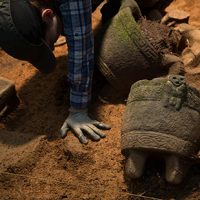As appearing on Chautauqua | Fall 2016
 Date: Thursday, February 16, 2017
Date: Thursday, February 16, 2017
Time: 7:00 PM
Location: Chautauqua Community House
Over the past year, the excavation of an ancient city in Honduras has yielded a trove of remarkable stone artifacts from a mysterious, unnamed Pre-Columbian civilization. A joint American-Honduran team of archaeologists led by CSU’s Dr. Chris Fisher uncovered and removed more than 200 sculptures from the base of a large earthen mound at the center of the site, which is being called the “City of the Jaguar.”
The Pre-Columbian city was discovered in 2012 using an aerial survey method called lidar that uses pulses of laser light to map the ground. The city was hidden under triple-canopy jungle in an unexplored valley, ringed by mountains, in a remote region known as La Mosquitia. Archaeologists first entered the ruins in February, 2015 and happened upon the cache on the second day of exploration. The excavated area encompasses less than 200 square feet of the enormous archaeological site, which includes at least 19 prehistoric settlements, probably part of a single chiefdom, spread along several miles of a river. One of the nearby sites has two parallel mounds that may be the remains of a Mesoamerican ballcourt similar to those left by the Maya civilization, indicating a link between this culture and its powerful neighbors to the west and north. The ballgame was a sacred ritual that re-enacted the struggle between the forces of good and evil, and might also have been a way for groups to avoid warfare by solving conflicts through a match instead. The ballgame was sometimes associated with human sacrifice, including the decapitation of the losing team or its captain.
While the City of the Jaguar is spectacularly isolated now, at its heyday it was probably a center of trade and commerce. “When you’re here today,” Fisher said, “you feel so disconnected. It’s a wilderness, and it’s hard to imagine you’re even in the 21st century. But in the past, it was in the midst of an intense network of human interaction. It wasn’t isolated at all.
About the Speaker:
Chris Fisher is a professor of anthropology at Colorado State University. He received his doctorate and MA degrees from the University of Wisconsin–Madison, and his undergraduate degree from Michigan State University. He has conducted fieldwork in several areas of the United States, Mexico, Portugal and Albania. His work is supported by the National Science Foundation, National Geographic, the Heinz Foundation and other agencies. In 2007 Fisher received the Gordon R. Willey Award from the American Anthropological Association.